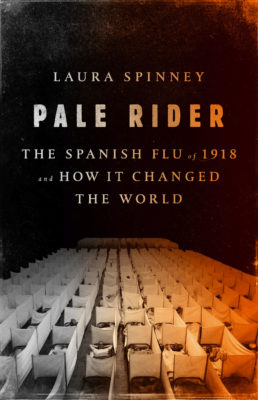 It’s become a standard bit of twentieth century trivia that as terrible as the First World War was, the 1918 flu pandemic coinciding with the armistice killed more than the conflict itself.
It’s become a standard bit of twentieth century trivia that as terrible as the First World War was, the 1918 flu pandemic coinciding with the armistice killed more than the conflict itself.
Now, an especially pedantic person might want to argue that WWI really was the beginning of the ‘Second Thirty Years War’.
They might treat as bookends both world wars — roping together all battlefield deaths, all civilian bombings, every atrocity and genocide, every preventable famine and epidemic.
And put together as a single historical event, they would claim, all the misery springing from human malice between 1914 to 1945 resulted in up to one hundred million deaths during those three decades.
But, as British science journalist Laura Spinney relates in her latest book Pale Rider, the pandemic known in its time as the Spanish Flu (but definitely not originating in Spain) may have killed as many people in three years as humankind did during thirty years of war, infecting one out of every three people on the earth while killing one in twenty of the global population.
Within a tidy 295 pages, Spinney asks (then attempts to answer) the question, “How did we allow ourselves to forget a tragedy of such enormity?”
Spinney’s technique for handling the material is in itself remarkable as she fast-forwards and rewinds, switches in scale from micro to macro, delving into how viruses were first seen under electron microscopes, explaining what the letters and numbers like H1N1 signify in how the flu functions, then zooming out to the path of disease across continents and its effects on societies along the way.
It’s in the third chapter where she most impressively balances the scales of personal and global, providing a seemingly endless series of anecdotes of the Spanish Flu’s progression as it intersects with people’s lives from China to Brazil to Alaska, and you feel how it matters to each person.
It’s the equivalent of the September 11th attacks, Challenger explosion or JFK’s assassination, except it was a tragedy experienced instead of received electronically.
The root of influenza in Italian is exactly as it sounds, referencing the influence of unseen powers on human affairs. But Spinney manages to also show the reverse: how humans influenced the spread and rapaciousness of the disease.
Most intriguingly, Spinney explores the idea that by putting this 1917 version of influenza into the cauldron of hell that the trenches of the Western Front were, it naturally developed into the most virulent and apocalyptic version of itself possible.
An officer disinclined to take a soldier off the front lines for a little fever would quickly change his mind when confronted with a soldier coughing up pints of pus and limbs turning black. That may have been the strain that got back to the general population.
In the end, the only noticeable failing of Spinney’s book is that she mentions early on how the vast majority of people died outside of Europe and North America — more than eighteen million people in India alone — yet she devotes relatively few pages to describing the impact the disease had on those places.
She does spend some time outside of her buying audience’s world, and whatever relative dearth of coverage may be due to the limited sources Spinney has available to her as a non-polyglot, non-specialist. But if you’re going to mention how more people died in India than “The War to End All Wars”, there’s an expectation you’re going to find a way to get a bit more specific about the flu’s effects there than, by my count, some small mentions across six or seven pages.
Nevertheless, Spinney has managed to research and write a concise but comprehensive work deserving to be part of your private library if you enjoy history or epidemiology whatsoever. It may even get you looking for more region-specific books the on pandemic to delve deeper into what she covered.
Unfortunately, it may also cause you break out into a cold sweat when you remember Republicans are looking to cut $1.2 billion from the budget of the Centers for Disease Control and Prevention next fiscal year.
